Gyaru
Gyaru (ギャル) is a Japanese transliteration of the English slang word 'gal' ("girl") used to define a fashion subculture in Japan. It is rumored to be inspired by the popular late 1980s American action drama series Baywatch, that also appeared on Japanese television. The fashion style was probably created and then popularized by Pamela Anderson's role in the show at the time.[1][2] It is rumored that gyaru was an exaggeration and over-representation of American teenage party culture in Japan. The term's usage peaked in the early 2000s, and has since gradually declined. This decline[3] has been referred to as a strategy of the magazine organizations,[4] over-exaggeration of the fashion,[5] western media[6] or even sometimes government policies. The meaning of the term gyaru gradually drifted to apply to a slightly older demographic whose apparent lack of interest in work or marriage resulted in these women being regarded as childish or a "hussy".[7] Due to its past and its present connotation, it is now used almost interchangeably with kogal.
.jpg)
During the Heisei era, Gyaru subculture was at its peak. It had a large influence on Japan's fashion and its economy, with multiple gyaru brands branching out before eventually declining.[8] In Tokyo, across the intersection from the Shibuya Station is a shopping mall called Shibuya 109. This was a popular location for purchasing gyaru style clothing, and was where this fashion subculture was most often seen. In the early 2000s, 109 was considered the source of the newest and trendiest items or brands for gyaru, from popular large recognized "Gal brands" to more independent local designers. Although 109 began as the primary source of gyaru style clothing, the style's growth in popularity saw brands reaching out by having their clothing available at pop-up stores in conventions or through web shops offering international shopping. Second-hand re-selling of gyaru apparel and accessories also increased their availability.
Description
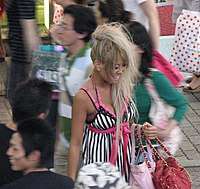
Gyaru is a description of either sex, but mostly women, who follow a type of Japanese street fashion with many subcategories, many types of which originated in the 1970s.[9] It is a fashion that is considered as not conforming to, and rebelling against, the Japanese standards of its society, at the time when women were expected to be housewives, and fit Asian beauty standards of pale skin and dark hair. For women this fashion was for them to be more racy and freewheeling, with some feeling it caused a ruckus, juvenile delinquency and frivolousness.
Its popularity peaked in the 1990s and early 2000s. In the 2010s gyaru fashion for women was typically characterized by having heavily bleached or dyed hair (mostly shades from dark brown to blonde), depending on style the hair may be heavily crimped up (which is called sujimori (スジ盛り) hair in Japan). Tanned skin, highly elongated, decorated nails, and dramatic makeup are considered to be essential in this fashion subculture. The makeup typically consists of dark eyeliner, fake eyelashes to make the eyes appear larger, contouring of the face and nose for a slimming effect, and using colored contacts to change the color of their eyes and make the eyes appear larger. They are also known for partying or clubbing, being rather provocative, being flirtatious and unwinding and having fun.
Apparel for gyaru fashion differs depending on which gyaru style the individual has chosen and also where they would buy their items. Japanese brands or western fast-fashion brands would determine their style in the gyaru fashion subculture. Some would have the luxury to buy from western high-end or haute couture brands, but those who lived in Japan mostly stuck to certain brands from Japan itself depending on their style, often originating from Shibuya 109.

Popular recurring gyaru models, icons and idols who may have been easily recognized during its peak were Tsubasa Masuwaka, Kumiko Funayama, Rie Matsuoka, Hikari Shiina, Satomi Yakuwa, Sayoko Ozaki, Yuka Kowara, Rina Sakurai, Nana Suzuki, and twins Chika & Chie Yoshikawa.
Common gyaru styles

There are various subcategories of "gal" fashion depending on the choice of apparel and gender.
- gyaru-kei (ギャル系): the most common gyaru style. It is an umbrella term for the many subcategories or themes of gal styles.
- Ganguro (ガングロ): a gyaru with an artificial deep tan and bleached hair, and makeup which tended to use white around the eyes and on the lips, and darker shades on the eyes. Also, decorations such as glitter or flowers, such as hibiscus flower stickers added under the eyes. This style was popular in the late 1990s and early 2000s.
- Manba (まんば):[10] Manba is darker than ganguro, but also wilder than ganguro. Manba would wear sexy outfits from very short to very long dresses, or shorts to long skirts. Accessories (such as bangles, beads, etc.) would also include the motif of flowers such as leis or hibiscus, of which these patterns would appear on their clothes. Colorful clothing was considered to be essential. They would sometimes wear sweatshirts, pants, and leg warmers. Disney characters made an appearance as a choice of fashion apparel such as characters from Lilo & Stitch and also characters from the Mickey Mouse franchise. The white lips remained and white eye shadows were applied. A manba's eye shadow can also be placed on a different place around the eyes. The amount of eye shadow could vary greatly. Some manbas also used a different eye shadow color on their eyelids. The use of glitter was acceptable as well. Stickers weren't used under the eyes anymore, instead, they were replaced with rhinestones (however they did not necessarily put them on). Common hairstyles featured big hair, bouffant, high ponytails with hair partly down, synthetic dreads, ribbons braided in, teased, side-swept, fringe, braids, curled, simply straight, or very colorful. Popular hair accessories included leis and other types of flowers/bows, straw cowboy hats, or straw hats. Flip flops, sandals, platform sandals, slippers, crocs, boots or leg warmers could also be worn.
- Yamanba (やまんば): like manba, but the nose contour stripe is white-colored and goes past the eyebrows. Yamanaba also means "old mountain hag" in Japanese, the style was regarded by the Japanese civilians as improper or even dirty.
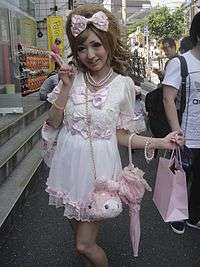
- Banba (バンバ): Banba is a lighter form of manba. Banbas wear less white makeup than manbas, they also use more glitter, and may or may not have neon-colored hair. Banbas wear more extreme-looking types of false eyelashes, and colored contact lenses. Banbas wear darker colors than manbas and sometimes dress in clubwear.

- Hime-gyaru: also known as Hime-kei, is one of the more over-the-top and one of the most expensive styles of dress of all of the categories since it is considered to be essential to buy the brand-names 'MA*RS' or 'Princess Melody'. The hime style is largely based on the Rococo era. Gyaru of this style wear dresses or skirts in pink or other pastel colors with lots of laces and bows. Rose patterns, rosettes, pearls, and crown motifs are also very common. Headpieces range from large bow clips with pearls to headbands with a rose accent, while the hair is either bleached in a certain color, crimped in a bouffant at the top and curled or wigs/extension are worn to create that sujimori styled hair (スジ盛り). This make-up style has even more exaggerated eyes than the typical gyaru. Hime-gyaru does not only include clothes, but many girls see it as a way of life and make or buy custom-made decor for their homes. The style blossomed in the early 2000s but has since declined or turned more casual (this version is referred to as hime kajii, but this style mostly uses the fashion brand 'Liz Lisa' rather than the now obsolete brand Princess Melody), though it is still present today in some subcircles. Not to be confused with Lolita fashion.
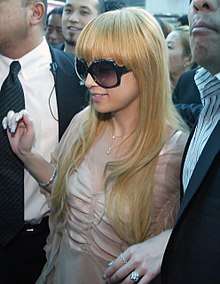
- Agejo (上げ嬢): a style that was highly active, agejo was mostly inspired by, and its aesthetic referenced in, the magazine Koakuma Ageha. It is a very foxy, ladylike, and mature style. It is generally worn by, but not always exclusive to, a hostess. The intention is to be flawlessly glamorous and desirable. The agejo style has an emphasis on the eyes, often enlarging and enhancing them with circle lenses and several sets of false eyelashes in an alluring way. The hair is always styled in an up-do, almost like hime-gyaru, with curls or hair that is crimped in the sujimori hair style(スジ盛り), and sometimes includes extensions and wigs. It is common for those participating in the agejo style were to wear multiple wigs at the same time. The agejo style is similar to hime-gyaru, except for being more skimpy and with the intention to be classy.
- Kyabajō (キャバ嬢): the style kyabajō is similar as agejo is inspired since the publication of Koakuma Ageha, which insisted and engrossed women to work in Kabukicho as a hostess, which the Japanese society is still trying to disregard even though this magazine did impact young women to make that choice. They dress in a particular style that makes them mostly wear dresses that are revealing but not too much, from the Japanese brand MA*RS or from the Jesus Diamante. The most exceptional about this style is that these women who participated in this style have unbelievably long fake nails. A market researcher named 'Miura Atsushi' (暑し三浦) did research on the women or young ladies who participated in kyabajo, he wrote a book about the whole situation that Japan had to go through with these women, called Onna ha naze kyabakurajō ni naritai no ka?(『女はなぜキャバクラ嬢になりたいのか?』 or "Why do women want to become kyabajō?")[11][12]
- Amekaji (アメカジ) or "American casual": it is usually a very bright, fun, flamboyant and generally multi-colored style, inspired by fictionalized images of America. Clothes are generally looser than most of the other styles. They usually have many layers that overlap each other. It mostly involves sweaters, bomber-jackets from the early 2000s and coats such as letterman jackets. In the summer they would wear t-shirts and cargo pants. Also, they would sometimes wear their boyfriend's clothes. Shoes were mostly tennis shoes, uggs or engineer boots. Girly shorts are welcome (for the girls).
- Gyaruo (ギャル男): a male gyaru. Typically, gyaruo have similar elements to their appearance with gyaru in terms of having high volume styled hair, trendy fashion styles, and sometimes tanned skin.
- Kogyaru: generally a gyaru dressed as a Japanese high school student, but the term comes from the Japanese high school students that during the late 1980's to early 1990's dressed this way during or after their school session by loosing their socks, putting on makeup and going to Tokyo. (高校生 kōkōsei).
- JK gyaru: a term for gyaru who participated in the JK business or are associated with these business practices. They also belong to the substyle kogal, since most of these girls were high school students when being employed in this type of business.
- Ane gyaru: a gyaru style that has the yanki and biker gang culture with gyaru makeup and style. The girls drive or ride bikes, and tend to have tattoos and piercings. They not only look rebellious, but the style caters to girls who live on the edge. Ane gyaru is a tougher version of onee gyaru, and is for more mature and virile, yet effeminate, gals. The magazine of choice for fans and followers is 'Soul Sister', a relatively new magazine.
- Gyaru-mama (ギャルママ):[13] teenage gyaru or women who continued with the style even after having children. BBC News states: "Gal-mama are young mothers who refuse to shed their gal-ness".[14][15] They also would clothe their children in the same style, meaning a boy would look like a gyaruo while girls would look like a gyaru, but the style would depend on the mothers' personal choice of style or which subculture she belonged to.
- Bibinba (ビビンバ): this look usually includes a lot of gold and jewelry. It is similar to b-gal.[16] It was said to be a joke in the Egg magazine and was not a serious style.
- Neo-gyaru (ネオギャル): the name was coined for gyaru that wanted to revitalize the style during the 2010s during its decline. By the time the style reached popularity and people have noticed its existence, the community of gyaru reacted in a completely different way than what some antiquated, radical, older or more fanatical gyaru were used to, some even shunned the style. But those who were wearing said fashion were not using the same fashion style as before or in its traditional form to wear, from apparel to their makeup. A style which is thought to be created by a previous gyaru model Alisa Ueno 上野アリサ, who owns the Japanese brand 'FIG&VIPER'.[17] It looks more western-like or even resembling grunge wear.[18] The makeup was also considered dark in terms of lipstick or eyeshadow.
- Gyaru-Den (ギャル電機): a style of gyaru consisting of reviving gyaru through technology. It takes aspects of the gyaru fashion subculture and then makes use of technology as a way to revamp the style. The creators of this style have created all of their items themselves, which can be LED-lights or synthesizers which are used on accessories such as necklaces, loose socks (ルーズソックス) or different apparel pieces. Kyoko (京子) from Japan and Mao (เหมา) from Thailand who immigrated and went to Japan and has a degree in Engineering, are the creators of this style.[19][20]
- Ishoku Hada Gyaru (異色肌ギャル, unique skin gal): is a gyaru style that consists of taking ganguro to an even higher level than manba or yamanba. Instead of making one's skin color twice as dark as usual, instead face paint is used or the person physically dips themselves in a colorful paint, to resemble something like an extraterrestrial, but with the same essential gyaru makeup. The creator of this style Miyako Akane (あかねみやこ) states in an Arte interview:[21] "I decided to create this style since that this style was created due to the fact that westerns have different hair and skin colors compared to the stereotypical Japanese features of pale clear skin and black hair, so when we want to do this we have to do something drastic. So, by changing our skin color or painting it we get to liberate ourselves; it's like a therapy from makeup, we are allowed to choose our hair color and skin color". She also states that "There are many mixed marriage children that are subject to a number of prejudices because of their skin color or their hair color; that's why I want to help by saying loud and strong that everyone is allowed to be whom they want to be." She also stated in an online interview[22] that: "I decided to create this style based upon by many things apart from gyaru, but also Harajuku fashion and of course the idea of extraterrestrials; of course it is kawaii gyaru (かわいいギャル)." In a Kotaku interview[23] she stated that she has "longed for the interesting skin tones see in video games, anime, and movies". This fashion substyle in gyaru has been promoted in the Egg magazine.
Western gyaru or gaijin gyaru
Often referred to as foreign gyaru or western gyaru and online as gaijin gyaru (外人ギャル). Women and even men who have found gyaru fashion outside Japan and have decided to participate in said fashion subculture (western gyaru includes countries also outside of the West, such as the Middle East). Western or gaijin gyaru created their own communities or groups and forums which they communicate among each other. They also had lists of tutorials to help beginners to gyaru, with makeup and hair tutorials.
Gyaru got its popularity outside of Japan due to the help of selling Gyaru magazines in Western countries and social media networks that helped spread this Japanese fashion style further than its origin to other parts of the world.
In 2011 these western or gaijin gyaru held their first event to spread awareness of this style,[24][25] these ones lasted till 2014 and they were mostly done online. Since 2014 there wouldn't be another contest until 2019,[26] which has held an actual event which wasn't online. These contests were made so one could vote for who would be the best suited for certain categories and gaining an internet attention from peers when winning a category.
During the early 2000's, most anime conventions saw a glorification of gyaru and gaijin gyaru presence as they held gatherings or "meet's" usually organized by their gyarusa and fellow peers in these conventions in their country of residents or where their gathering would be held in.
As of 2018/2019 there was a big boom in activity for the gaijin gyaru community caused by the comeback of Egg magazine as well as general popularity of gyaru increasing again in Japan. This has affected the gaijin gyaru community as well, but a new gaijin gyaru magazine (Papillon) got published in October 2019 as well as Gyaru-go making a comeback.
Related media
Clothing brands
.jpg)
.jpg)
Magazines
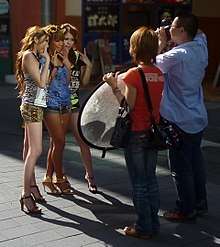
- AneAgeha[46]
- Blenda
- Decolog Paper
- Egg
- Edge Style
- MensEGG
- Happie Nuts
- I Love Mama
- Katy
- KiLala
- Jelly
- Koakuma Ageha
- Nicky
- PopSister
- Popteen
- Ranzuki
- SCawaii!
- Soul Sister
Music and acting
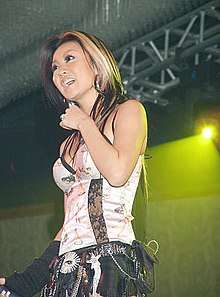
Music is not necessarily a main hobby within gyaru culture, although J-pop and Eurobeat remixes are regularly danced to with the dance parapara (パラパラ), however there are many popular Japanese singers who are casually listened to, mostly during a date or when driving a car. Singers such as Koda Kumi, Namie Amuro and Ayumi Hamasaki are popular both in Japan and overseas, and regarded as inspiration for many gyarus. Other J-pop artists that were considered to be essential to listen to were LOVE to LOVE, GAL DOLL, Rady[47] and Juliet.[48] A music group called LADYMADE often used gyaru models at the time, such as Yuka Kowara (Yunkoro). They also listened to Eastern & Western rock, rap and all sorts of genres, as long as it fitted the gyaru aesthetic.
Prominent models or members of the gyaru community may also try building a musical career or acting career. Tsubasa Masuwaka (as Milky Bunny),[49][50] Aina Tanaka & Yumachi Takahashi forming the girl group 'SHIBUYA GIRLS',[51] Rina Sakurai having the main protagonist role in her own movie and the Black Diamond members are some of the very few prominent gyaru to have built a career.[52]
Dancing
A regular pastime for gyaru is parapara (パラパラ), it is a dance performed mostly with hands and legs going back and forth, from left to right to be precise. It is mostly danced with Eurobeat music. The most infamous parapara song and tagline is "GET WILD & BE SEXY" which was of an infamous eurobeat song of the same name, by the group called CREAM.[53] There is a diverse choice number of songs that can be danced to parapara. There are even dedicated channels to parapara on YouTube that are still active to this day.[54]
Hobbies
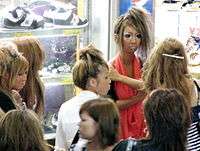
A common hobby of gyaru is Purikura (プリクラ). These photo booths are often used whether in a group or taking pictures in these photo booths alone, doing ridiculous or gaudy poses depending on the mood of the pictures are frequently done. These booths are mostly located in the electronic district of Tokyo, Akihabara, they were the thing to do for gyaru enthusiasts and even models participated. These booths are a creative outlet, sometimes hobbyist obsession but also in some ways it is a form of get someone interested to get recognized for a magazine in Japan. These photo booths would often use or find the pictures one has made and posted on multiple social network services for the magazine and would often have the chance to become a Dokumo model,[55] which these models were often referred to as by the magazines themselves. Another hobbyist activity is "Decoden" or also Keitai art (ケータイ芸術), which also originated in Japan. The word "deco" comes from decorative while "den" is a paraphrasing of the words "phone" (In Japanese, 電話 Denwa, meaning phone) creating the term "Decoden". In its original form it is truly ostentatious, by looks and by how heavy the actual material is, which consists mostly of polymer clay and even hardware store silicone for the cream. They would also accessorise their mobile phones with mobile phone charms or danglers. Multiple famous gyaru models participated in an advertisement called 'Deco-Pocky' which was sponsored by the magazine 'Popteen' where gaudy adds were created.[56]
Events and meetings
A group of gyaru who would often meet each other and hang out is called a "gal circle" (ギャルサークル). They are two types of groups: Nagasa (長さ), which are casual groups to hang out with each other, and Ibesa (イベサ), which would plan, host, and have events with each-other. These events would consist of clubbing, karaoké, purikura, and showing off each other's outfits. One of the most famous gyaru groups is Angeleek, who predominantly wore ganguro even though the most popular styles in those circles were manba and yamanba, and which consisted of at least twelve members. They have been promoted numerous times in Egg magazine and on national Japanese television.
Cafés
The Ganguro Café in Shibuya, which once used to be the home of the gyaru and ganguro style, was closed in July 2018.[57][58][59][60]

Gyaru scandals in Japan
In 2012 the gyaru model Jun Komori committed fraud and helped with said fraud on an online auction website in Japan. She worked with the at the time thirty year old Ryusuge Suzuki, who was the penny orders section owner of the 'World Auction' website in Japan. She had to close her official web blog due to the backlash of her actions.[61] Another later scandal happened at a Shinjuku 'Lumine EST' mall to gyaru staff members on February 3, 2015. Three 'Rady' shop staff were arrested and charged with stealing clothes. The crime occurred due to shop staff only getting paid around 880 yen an hour. The 'Rady' store was closed within the same month.[62] Oyajigyaru (オヤジギャル):[63] isn't a style,[64] rather it is a title that gyaru have gotten themselves because of their manner of showing and acting out towards others on the street, these gyaru have carried as the over prevailing years of its existence of as a subculture of Japanese street-fashion. Over these years of its existence it has garnered them this title of Oyajigyaru, especially when this title has been given by the Japanese population when asked in a survey of the most used words of the decades or buzzword rather which are used on a daily basis. Because of their rudeness towards others, masculine character: such as drinking beer, smoking in public places, swearing, overtly sexual manner of dress and almost remotely relaying on older men for money acting like streetwalkers.[65] Oyajigyaru literally means an old-man girl and is used as slang to describe most revolting gyaru.
Influence in manga, anime, Internet notoriety and video games
Gals! was a manga that had an impact and a great influence on said fashion. It was created by the female mangaka Mihona Fujii in 1998 and is a shoujo manga that has become yet again quite renowned in the subculture of gyaru. A more recent manga was Gal Japon,[66] published in 2010.
There are many others creating characters in this particular fashion subculture. For example, Peach Girl, a manga created by Miwa Ueda which started publication in 1997. A more recent one, that was published in 2016, would be Gal Gohan (ギャルごはん),[67] a manga about cooking at school. A stop motion anime series named Milpom[68] was created to promote the gyaru lifestyle, especially its television pilot, but in the end drifted towards other Japanese fashion subcultures. It was released in 2015 and lasted till 2017, due to lack of viewership and bad reviews. Another manga that started in 2015, was Komi Can't Communicate, a manga that does not disscuss about gyaru but has a ganguro in it, her name is Manbagi Rumiko. In 2014, the manga and anime series Please Tell Me! Galko-chan[69][70] began, which mostly talks about gender differences, sexual behavior or body complexes and differences in both the female and male bodies. Galko-chan is the protagonist but she also has an older gyaru sister. A 2018 manga called Gal & Dino features a gyaru as the lead and eventually got an anime in 2020.[71]
On the internet, there are many makeup tutorials and event videos of gyaru meeting each other on YouTube. There are a lot of different videos that talk about this fashion subculture, such as article videos, history videos, makeovers and questionnaire videos.[72] There are also parody videos about this style, one of the most famous being the 2011 video with four million views titled 'Gal o sengen' (GAL男宣言) created by the Japanese music group 'POLICEMAN110' or known in Japan simply as 'ポリスマン' ('Porisuman').[73] It makes a farce of the gyaru life style especially gyaru-o's.
The Persona series had a gyaru. In Revelations: Persona, there is a kogyaru named Yuka Ayase.
The Girls Mode series (known as Style Savvy and Style Boutique in North America and the PAL region respectively) is based on multiple Japanese street fashion subcultures and has a focus on brands and had a brand that mimicked a gyaru fashion brand, the in-game brand AZ*USA (AZ-USA in the West). Amekaji also got its own brand named CherryBerry (April bonbon in the West). This series has three sequels on the Nintendo 3DS.
See also
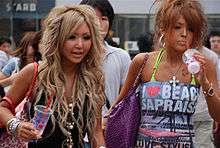
- AV idol
- Burusera
- Cosplay restaurant
- gyaru-moji, a type of lettering used in mobile phone messages by girls
- Host and hostess clubs
- JK business
- Maid café
- Panchira
- Uniform fetishism
- Sun tanning
- Zettai ryōiki
References
- "Gyaru, Ganguro and the Western Gaze – Dining with Dana". Retrieved September 14, 2019.
- Nursall, Alex (June 1, 2016). "The Brush Off: A Look at Gyaru, Ganguro, and Manba". The Toast. Retrieved September 14, 2019.
- "Past and present photos of Japanese fashion models make us wonder, where have all the gyaru gone?". SoraNews24 -Japan News-. March 30, 2015. Retrieved July 16, 2019.
- Hime Hime Star (February 12, 2015), Beginner Guide to Gyaru: History of Gal, retrieved July 16, 2019
- Mitsu (January 3, 2015). "The Fall of Gyaru an easy target and masking the problems with Japan teen fashion". universal-doll.com. Retrieved July 16, 2019.
- "GxL BiBLE: Your Guide to Gyaru Style, Live from Tokyo: How social media has impacted on Gal makeup in 2017". GxL BiBLE: Your Guide to Gyaru Style, Live from Tokyo. Retrieved September 14, 2019.
- "The History of gyaru part one".
- "A blog post about the possible & inevitable decline".
- "The History of the Gyaru – Part One" NéoJaponisme. Retrieved February 28, 2012
- "New Manba (2004-officially... | What is Gyaru?". July 3, 2016. Archived from the original on July 3, 2016. Retrieved August 30, 2019.
- "Amazon co jp of where you can purchase the book".
- "Why do women want to become Kyabajō". bookmeter.
- "葉酸サプリおすすめランキング". 葉酸サプリメント. Retrieved January 9, 2016.
- Oi, Mariko (August 30, 2012). "Japan harnesses fashion power of gals". Retrieved September 21, 2019.
- "Switching to mama mode is not easy for today's gals". Retrieved December 24, 2012.
- Mitsu (March 19, 2012). "B-Gyaru Introduction". universal-doll.com. Retrieved September 14, 2019.
- Mitsu (February 25, 2012). "New Gyaru Brand: Fig &Viper". universal-doll.com. Retrieved September 14, 2019.
- Beginner Guide to Gyaru: History of Gal, retrieved September 14, 2019
- Mitsu (March 1, 2017). "Keeping Gyaru alive with Galden – Gyaru Technology". universal-doll.com. Retrieved September 14, 2019.
- The Evolution of Kawaii Culture – Ver. 3.0 – - Kawaii International | NHK WORLD-JAPAN On Demand, retrieved September 14, 2019
- Ishoku Hada Girls – TRACKS – ARTE (in French), retrieved September 14, 2019
- "Interview With Ishoku Hada Gyaru Trendsetter miyako". Japanese kawaii idol music culture news | Tokyo Girls Update. Retrieved September 14, 2019.
- Ashcraft, Brian. "Body Paint Makes For Colorful Japanese Fashion". Kotaku. Retrieved August 24, 2019.
- "Gaijin Gyaru Awards 2011 Nominees YouTube video". Retrieved April 22, 2011.
- "Gaijin Gyaru Awards 2011 YouTube video". Retrieved May 7, 2011.
- "Gaijin Gyaru Awards 2019 YouTube video". Retrieved August 24, 2019.
- http://universal-doll.com/2013/05/gyaru-university-japanese-gyaru-clothing-brands/. Retrieved May 7, 2013
- "CECIL McBEE OFFICIAL SITE". CECIL McBEE – セシルマクビー (in Japanese). Retrieved September 20, 2019.
- "CECIL McBEE(セシルマクビー)|公式ファッション通販サイト Ailand(アイランド)". ailand-store.jp. Retrieved September 20, 2019.
- tokyofashion.com http://tokyofashion.com/cocolulu/. Retrieved September 21, 2019. Missing or empty
|title=(help) - "ココルル公式オンラインショップ – Yahoo!ショッピング". store.shopping.yahoo.co.jp. Retrieved September 20, 2019.
- "DaTuRa web-store".
- Mitsu (December 14, 2014). "Datura Japanese brand fashion Oneegyaru style". universal-doll.com. Retrieved September 20, 2019.
- "Duras official website".
- "Egoist official website".
- "EGOIST Japan Online Shopping Site | FASBEE". fas-bee.com. Retrieved September 20, 2019.
- "GOLDSinfinity -ゴールズインフィニティ- (@golds.infinity) • Instagram photos and videos". instagram.com. Retrieved September 21, 2019.
- "GHOST OF HARLEM (@ghostofharlem) • Instagram photos and videos". instagram.com. Retrieved September 21, 2019.
- "JESUS DIAMANTE [ジーザスディアマンテ] |". jesusdiamante.co.jp. Retrieved September 20, 2019.
- "LiLimPark – MA*RS(マーズ)、プリメロの公式ストア |". lilimpark.jp. Retrieved September 20, 2019.
- "Rady web-store".
- "Resexxy official website".
- "Rienda official website".
- "WCJAPAN". wc-japan.com. Retrieved August 31, 2019.
- "Tumblr blog PopCutie about gyaru, this page includes all models and magazines". Tumblr. Retrieved September 20, 2019.
- "姉ageha (@aneageha_info) | Twitter". Twitter. Retrieved September 14, 2019.
- "ZIPANG CREATE". zipang-create.com. Retrieved September 14, 2019.
- who were produced at the time by Universal Music Japan
- "(Text in Japanese)益若つばさますわかつばさ/Tsubasa Masuwaka's Artist Milky Bunny Discography",Oricon
- (text in Japanese)Oricon Style, Retrieved 13 September 2015. July 13, 2011
- "Yumashi & Aina Gathering the Girls of Shibuya and Become the Producers of this Large Group"MUSICJapanplus
- "(Text in Japanese)強め"黒肌"ギャルの全国ユニット/BlackDiamond gyarusa website", 強め"黒肌"ギャルの全国ユニット/BlackDiamond group
- "Eurobeat song from CREAM GETWILD&BESEXY".
- "パラパラ遊楽町@香港". Retrieved August 30, 2019 – via YouTube.
- "Dokumo modeling".
- Katherine (February 27, 2010). "Deco Pocky". Retrieved September 16, 2019.
- "Gyaru fashion subculture tribute space Ganguro Cafe in Shibuya to close in July". Japan Trends. Retrieved September 14, 2019.
- "Real Harajuku Girls: Getting a Japanese '90s "Gyaru" Style Makeover at Shibuya's Ganguro Cafe!". LIVE JAPAN. Retrieved September 14, 2019.
- THE LAST GYARU GIRLS OF SHIBUYA |Kurogyaru Makeover at the Ganguro Cafe Tokyo, retrieved September 16, 2019
- "Gyaru United: Japan's Black Diamond Gals Champion a Kuro Gyaru Subculture Revival". Tokyo Fashion News. November 24, 2012. Retrieved September 20, 2019.
- "Jun Komori shuts down blog following fraudulent auction site scandal". Japan Today. Retrieved September 20, 2019.
- Mitsu (February 22, 2015). "Bizarre Shop Staff Theft shuts down Shinjuku Lumine Rady". universal-doll.com. Retrieved September 20, 2019.
- "Japanese website documenting the use and prevalence of this slang word". resemom. Retrieved November 14, 2013.
- Japan and the Shackles of the Past. R. Taggart Murphy. p. 238. ISBN 0199845980.
- "Blogspot that is about gyaru". All about gyaru. Retrieved May 22, 2011.
- "Gal Japon". MyAnimeList.net. Retrieved September 21, 2019.
- "Gal Gohan". MyAnimeList.net. Retrieved September 21, 2019.
- "Official Milpom anime website".
- "『おしえて!ギャル子ちゃん』公式サイト". 『おしえて!ギャル子ちゃん』公式サイト (in Japanese). Retrieved September 13, 2019.
- "TVアニメ『おしえて!ギャル子ちゃん』公式サイト". galko.jp. Retrieved September 13, 2019.
- "ギャルと恐竜". 「ギャルと恐竜」公式サイト (in Japanese). Retrieved September 14, 2019.
- Prejudice or Sexy? What Japanese REALLY think of GYARU GIRLS in Japan., retrieved September 16, 2019
- ポリスマン/GAL男宣言, retrieved September 16, 2019
External links
| Wikimedia Commons has media related to Gyaru. |
- https://savvytokyo.com/4-fashion-trends-changed-japans-history/
- https://www.japantrends.com/hostess-culture-magazine-koakuma-ageha-closes-down/
- https://www.japantrends.com/gyaru-magazine-egg-closes-is-gyaru-fashion-culture-on-the-way-out/
- http://tokyofashion.com/marui-one-international-japanese-fashion-web-shop-shuts-down/
- https://www.japantimes.co.jp/life/2005/08/21/to-be-sorted/end-of-an-era-in-shibuya-style/
- https://japantoday.com/category/features/where-have-all-the-gyaru-gone
- http://yabai.com/p/2272
- https://kotaku.com/outrageous-japanese-fashion-wants-to-go-global-510246927
- https://unseenjapan.com/gyaru-culture.html
- http://neojaponisme.com/2012/02/28/the-history-of-the-gyaru-part-one/
- http://neojaponisme.com/2012/05/08/the-history-of-the-gyaru-part-two/
- http://neojaponisme.com/2012/06/06/the-history-of-the-gyaru-part-three/
- https://littlemisswonderland.com/what-is-gyaru/
- https://www.youtube.com/watch?v=TA5l2FlnHaI